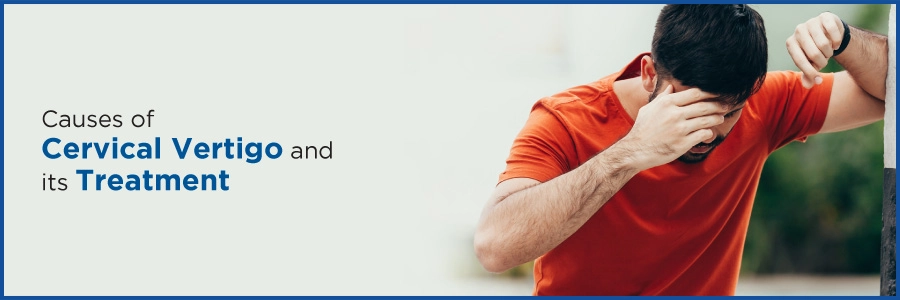- Cardiology 84
- Dermatology 45
- Endocrinology 33
- ENT 16
- Fertility 190
- Gastroenterology 78
- General-Medicine 81
- Gynecology 80
- Hematology 19
- Infectious-Diseases 33
- Neurology 52
- Oncology 34
- Ophthalmology 23
- Orthopedics 69
- Pediatrics 31
- Procedure 23
- Public-Health 144
- Pulmonology 59
- Radiology 8
- Urology 68
- Wellness 161
- Woman-and-child 77

Overview of Cervical Vertigo
Cervical vertigo is a condition where dizziness or vertigo is linked to issues in the cervical spine, or neck. This type of vertigo can be triggered by various factors related to neck problems, making it important to understand its symptoms, causes, and treatment options.
Cervical Vertigo Symptoms
Cervical Vertigo Causes
Atherosclerosis
Blockages in the arteries of the neck may lead to injury in the area that could cause vertigo. This could be due to atherosclerosis, which is the thickening of the artery walls.
Neck Injuries
Neck pain is frequently associated with people suffering from cervical vertigo. Cervical vertigo can be caused by a variety of factors, most of which are caused by a traumatic injury to the neck. Whiplash from a car accident, for example, can cause damage to the head and neck, resulting in cervical vertigo.
Osteoarthritis
The most common type of arthritis affecting millions of people worldwide is osteoarthritis. It happens when the protective cartilage that cushions the ends of your bones worsens. The hands, knees, hips, and spine joints are the most commonly affected by the disorder. Advanced osteoarthritis in the spine can cause the vertebrae in the neck to wear down, extra pressuring the nerves, arteries, and the spinal cord itself.
A slipped disk
Slipped discs are more common in the lower back, but they can occur anywhere along the spine. When the softer center of a spinal disc pushes out through a crack in the spine, it is called a slipped disc or herniated disc. Sometimes, it may push into a nerve or artery, causing symptoms such as cervical vertigo.
Poor posture
Cervical vertigo may also be caused by poor posture. The cervical spine may compress over time because of poor sitting posture or issues like "text neck," in which a person frequently bends their neck to look at electronic devices or books.
Cervical Vertigo Treatment
Physical Therapy
Exercises and stretches prescribed by a physical therapist can help improve neck muscle strength, flexibility, and posture, reducing symptoms of cervical vertigo.
Medications
Pain relievers, muscle relaxants, and anti-inflammatory medications may be prescribed to alleviate pain and discomfort associated with cervical vertigo.
Neck Braces or Collars
These devices may be recommended to provide support to the neck and limit movement, especially in cases of severe cervical spine instability.
Lifestyle Modifications
Avoiding activities that exacerbate symptoms, such as prolonged sitting or repetitive neck movements, can help manage cervical vertigo.
Ready to take control of your health journey? Book your appointment now and start your path towards wellness today!
Book an AppointmentManual Therapy
Techniques such as massage, spinal manipulation, or mobilization performed by a chiropractor or osteopath may help relieve muscle tension and improve neck function.
Postural Correction
Learning and practicing proper posture techniques can reduce strain on the neck and improve overall spinal alignment, potentially reducing cervical vertigo symptoms.
Surgical Intervention
In rare cases where conservative treatments fail to provide relief or there is significant cervical spine instability, surgery may be considered to address underlying structural issues.
Conclusion
Cervical vertigo can significantly impact daily life, but understanding its symptoms, causes, and treatment options can help manage the condition effectively. If you experience symptoms of cervical vertigo, seeking professional medical advice is essential to receive proper diagnosis and treatment.
Frequently Asked Questions
Address neck issues with physical therapy, medications, lifestyle changes, and manual therapy.
While usually not life-threatening, vertigo can indicate underlying health issues and may require medical attention.
Cervical vertigo relates to neck problems affecting balance, while BPPV stems from inner ear issues. Cervical vertigo is triggered by neck movements, BPPV by head position changes.
Treatment varies by cause, including medications, exercises, or procedures. Consult a healthcare professional for proper diagnosis and treatment.
Certain exercises to improve neck muscle strength, flexibility, and posture can help manage cervical vertigo. Consult a healthcare professional before starting any exercise regimen.
Untreated cervical vertigo may cause persistent balance issues, increased neck pain, and reduced quality of life. Early diagnosis and treatment can prevent complications.
Cervical vertigo is more common in older adults due to age-related cervical spine changes. It can also affect younger individuals, especially those with neck trauma or specific medical conditions.

- Cardiology 2132
- Dermatology 168
- Endocrinology 135
- ENT 97
- Fertility 217
- Gastroenterology 232
- General 478
- General-Medicine 1685
- Gynecology 169
- Hematology 85
- Infectious-Diseases 208
- Neurology 207
- Oncology 345
- Ophthalmology 65
- Orthopedics 187
- Pediatrics 83
- Procedure 72
- Public-Health 209
- Pulmonology 126
- Radiology 13
- Second Opinion 311
- Urology 294
- Wellness 600
- Woman-and-child 447
Related Blogs
If you have any questions, please fill out the enquiry form or call us, and we will get back to you promptly.
040-68334455